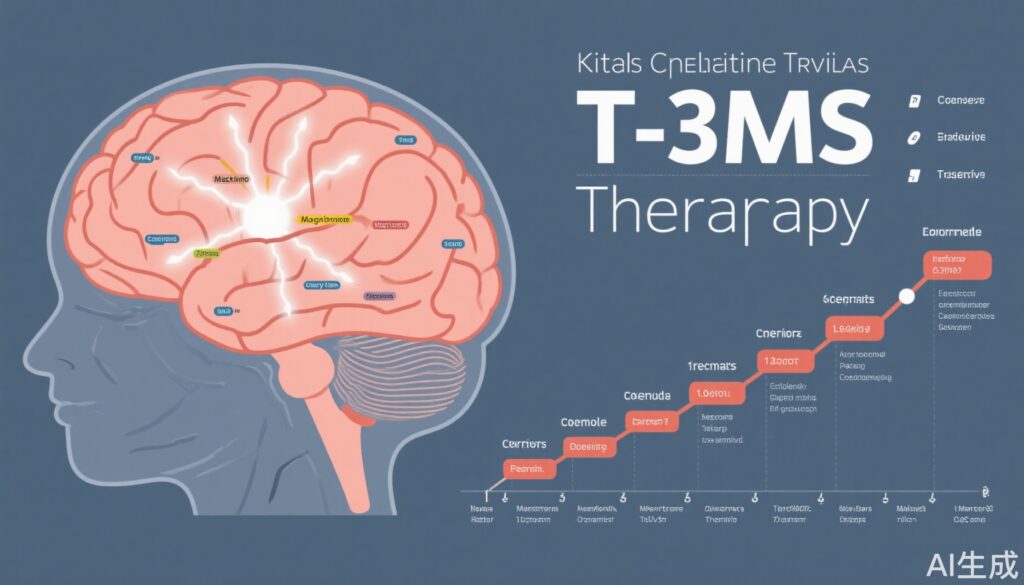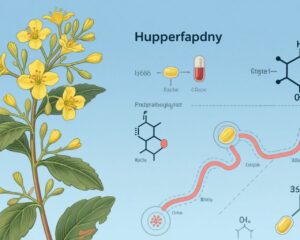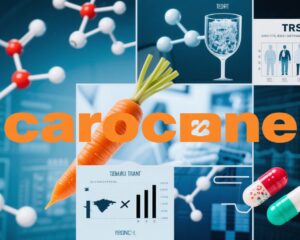Highlights
- Transcranial magnetic stimulation (TMS), including repetitive TMS (rTMS) and theta burst stimulation (TBS), shows robust efficacy in multiple neurological and psychiatric disorders such as depression, post-stroke rehabilitation, neuropathic pain, and ataxia.
- Meta-analyses and randomized controlled trials (RCTs) confirm the safety and efficacy of various TMS protocols, with emerging evidence supporting optimized parameters and combination therapies (e.g., TMS with cognitive or music therapy).
- Challenges remain concerning heterogeneity of responses, standardization of stimulation parameters, and mechanistic understanding, particularly in disorders like obsessive-compulsive disorder (OCD) and chronic pain syndromes.
- Future research trends emphasize personalized TMS dosing guided by neuroimaging, expanded transdiagnostic applications targeting symptoms like anhedonia, and long-term outcome studies to establish sustained benefits.
Background
Transcranial magnetic stimulation (TMS) is a non-invasive neuromodulation technique that uses electromagnetic induction to modulate cortical excitability and neuroplasticity. Since its introduction, TMS has evolved into several modalities—conventional repetitive TMS (rTMS), intermittent and continuous theta burst stimulation (iTBS, cTBS), and deep TMS (dTMS). These have been investigated across a spectrum of neurological and psychiatric disorders characterized by dysregulated neural circuits, such as treatment-resistant depression (TRD), stroke sequelae, neuropathic pain, obsessive-compulsive disorder (OCD), and hereditary ataxias. TMS’s favorable safety profile and potential to enhance rehabilitation and symptom control have garnered widespread clinical and research interest.
Despite advancements, clinical application of TMS faces issues including optimal stimulation parameters, variability in patient response, limited mechanistic insights, and the need for standardized protocols to maximize therapeutic outcomes.
Key Content
1. Neuropathic Pain and Spinal Cord Injury
A randomized, double-blind sham-controlled trial comparing intermittent theta burst stimulation (iTBS) and high-frequency rTMS in patients with spinal cord injury-related neuropathic pain reported significant pain reduction with both TMS protocols, with no significant difference between them. Importantly, iTBS may offer better convenience and patient compliance (PMID: 37982995). However, broader systematic reviews report that evidence supporting TMS’s effect on neuropathic pain interference remains limited and warrants further high-quality studies (PMID: 37428448).
2. Post-Stroke Rehabilitation
Meta-analyses reveal that low-frequency rTMS improves lower extremity motor dysfunction post-stroke, particularly when initiated within six months after stroke onset and applied over ≤15 days (PMID: 37991330). Complementarily, high-frequency rTMS targeting the dorsolateral prefrontal cortex (DLPFC) significantly enhances overall cognitive function in post-stroke cognitive impairment (PSCI) (PMID: 38113027). Intermittent theta burst stimulation (iTBS) also significantly improves global cognition, attention, visual perception, and daily living abilities among PSCI patients (PMID: 38150130).
Randomized controlled trials administering graded motor imagery combined with rTMS demonstrated superior upper extremity motor recovery compared to either intervention alone in stroke patients (PMID: 38110138). In post-stroke aphasia, meta-analytic data reveal that 15 sessions of 10-minute rTMS over the mirror area of Broca’s region yield significant language improvements, with sustained effects observed (PMID: 37984539). Combining low-frequency rTMS with music therapy in non-fluent aphasia after stroke showed enhanced language function and depression symptom relief compared to standard therapy or music therapy alone (PMID: 38088533).
3. Movement Disorders and Ataxias
Systematic reviews and meta-analyses report promising efficacy of rTMS in hereditary ataxia, particularly spinocerebellar ataxia type 3 (SCA3), demonstrating significant improvements in ataxic symptoms measured by validated scales such as ICARS and SARA (PMIDs: 38019418, 37975968). High-frequency rTMS appears more efficacious than low-frequency stimulation.
In cerebral palsy, combined low- and high-frequency rTMS demonstrate better effects on motor function than either frequency alone or conventional rehabilitation, although no significant improvements were observed for language function (PMID: 38117402). Safety of non-invasive brain stimulation (NIBS), including rTMS and transcranial direct current stimulation (tDCS), is supported in pediatric cerebral palsy, albeit with minimal impact on upper extremity outcomes, highlighting the need for larger, high-quality trials (PMID: 37528530).
4. Psychiatric Applications: Depression and OCD
Meta-analyses comparing theta burst stimulation (TBS) with standard rTMS for depression in 1124 patients found comparable efficacy and safety profiles, with TBS offering shorter treatment durations (PMID: 37831019). Accelerated protocols of continuous (cTBS) and intermittent TBS (iTBS) targeting the DLPFC demonstrated similar antidepressant effects in treatment-resistant depression (TRD), but cTBS showed superior reductions in suicidal ideation and anxiety (PMID: 38142717).
In obsessive-compulsive disorder, an umbrella review of 12 meta-analyses indicates that rTMS targeting the DLPFC and supplementary motor area (SMA) consistently reduces symptom severity, while deep TMS (dTMS) targeting medial prefrontal cortex (mPFC) and anterior cingulate cortex (ACC) yielded variable results amidst substantial heterogeneity (PMID: 38053347). Notably, a clinical trial comparing cognitive behavioral therapy (CBT) with low-frequency rTMS in OCD indicated CBT’s superiority in symptom and depression reduction, though no difference was observed in working memory improvement (PMID: 37938152).
In schizophrenia and depression, noninvasive brain stimulation showed medium-to-large effect sizes in mitigating anhedonia, a transdiagnostic symptom inadequately addressed by pharmacotherapy, underscoring potential broad applications (PMID: 38151800).
5. Mechanistic Insights and Pain Modulation
A crossover study exploring continuous and intermittent theta burst stimulation on human motor cortex during induced central sensitization revealed that cTBS may facilitate pronociceptive plasticity affecting secondary hyperalgesia, emphasizing the complexity of neuromodulation in chronic pain and the need for mechanism-based protocol refinement (PMID: 37952136).
6. Methodological Challenges and Reporting Quality
Systematic review of randomized controlled trials (RCTs) studying non-pharmacological interventions including TMS in concussion highlighted variable reporting completeness, often lacking crucial details such as intervention modifications and supervision, even in high-impact journals. Such gaps may impede reproducibility and clinical implementation (PMID: 37619783).
Expert Commentary
The collective evidence solidifies TMS’s evolving role as a versatile neuromodulatory tool with validated applications spanning neurorehabilitation and psychiatry. Its safety and tolerability make it a favorable option in populations with limited pharmacologic alternatives or refractory symptoms.
Despite this progress, significant challenges remain. High heterogeneity in study protocols, variable stimulation parameters (frequency, intensity, session number), and the diversity of targeted brain regions complicate cross-study comparisons and clinical standardization. The mechanistic basis for differential responses, especially in pain syndromes and OCD, requires elucidation to refine patient selection and optimize outcomes.
Translational efforts integrating advanced neuroimaging (fMRI, functional near-infrared spectroscopy) may pave the way for personalized TMS dosing and neurocircuitry-guided targeting. Combined modality approaches—for example, pairing rTMS with cognitive-behavioral or music therapy—demonstrate synergistic benefits, suggesting multimodal rehabilitation frameworks.
In pediatric populations and less-studied indications like hereditary ataxia, while safety is established, evidence of efficacy is less consistent, underscoring the need for larger, methodologically rigorous trials.
Regulatory bodies and clinical guidelines reflect growing endorsement of TMS for depression and post-stroke rehabilitation, yet incorporation into routine care is limited by logistical and economic factors. Continued efforts in refining protocols, ensuring comprehensive reporting, and conducting head-to-head comparative effectiveness research are critical.
Conclusion
Transcranial magnetic stimulation has made notable clinical advances as a non-invasive brain stimulation modality with proven benefits in depression, stroke rehabilitation, neuropathic pain, ataxia, OCD, and other neuropsychiatric conditions. The evolving landscape of TMS research emphasizes optimization of stimulation parameters, mechanistic understanding of neural plasticity modulation, and integration with adjunct therapies.
Persistent challenges include variability in clinical effects, need for standardization, and comprehensive evaluation of long-term outcomes. Future research priorities focus on personalized neuromodulation guided by biomarkers, expanded applications targeting transdiagnostic symptoms, and rigorous, large-scale RCTs to consolidate evidence.
With these strides, TMS stands to significantly enrich therapeutic options for a broad spectrum of patients suffering from disabling neurological and psychiatric disorders.
References
- Fujimoto K et al. Comparison of intermittent theta burst stimulation and high-frequency repetitive transcranial magnetic stimulation on spinal cord injury-related neuropathic pain: A sham-controlled study. J Spinal Cord Med. 2025;48(2):241-247. doi:10.1080/10790268.2023.2277964. PMID: 37982995
- Vakili M et al. Comparing the effectiveness of CBT and low-frequency rTMS in OCD: a clinical trial. Int J Neurosci. 2024;134(12):1635-1646. doi:10.1080/00207454.2023.2279500. PMID: 37938152
- Wang N et al. Optimal parameters of rTMS on lower extremity motor function post-stroke: systematic review and meta-analysis. Disabil Rehabil. 2024;46(21):4889-4900. doi:10.1080/09638288.2023.2283605. PMID: 37991330
- Fu L et al. Effects of Non-invasive Brain Stimulation on Hereditary Ataxia: a systematic review and meta-analysis. Cerebellum. 2024;23(4):1614-1625. doi:10.1007/s12311-023-01638-x. PMID: 38019418
- Wei Q et al. Efficacy and safety of rTMS in spinocerebellar ataxia type 3: a systematic review and meta-analysis. Cerebellum. 2024;23(4):1604-1613. doi:10.1007/s12311-023-01628-z. PMID: 37975968
- Chung S et al. Accelerated continuous vs intermittent theta burst stimulation in treatment-resistant depression. Biol Psychiatry. 2024;96(1):26-33. doi:10.1016/j.biopsych.2023.12.013. PMID: 38142717
- Rong L et al. Therapeutic effect of TMS on post-stroke aphasia and optimal treatment parameters: meta-analysis. Arch Phys Med Rehabil. 2024;105(7):1388-1398. doi:10.1016/j.apmr.2023.11.006. PMID: 37984539
- Ma Y et al. High-frequency rTMS on cognition in poststroke cognitive impairment: systematic review and meta-analysis. Am J Phys Med Rehabil. 2024;103(5):418-427. doi:10.1097/PHM.0000000000002377. PMID: 38113027
- Leung S et al. Effects of rTMS combined with music therapy in non-fluent aphasia after stroke. Int J Lang Commun Disord. 2024;59(3):1211-1222. doi:10.1111/1460-6984.12991. PMID: 38088533
- Zhang H et al. Efficacy of TMS in obsessive-compulsive disorder: umbrella review of meta-analyses. CNS Spectr. 2024 Apr;29(2):109-118. doi:10.1017/S1092852923006387. PMID: 38053347



